The transit industry carried 37.5 percent as many riders in December 2020 as it had in December 2019, according to data released last week by the Federal Transit Administration. This is a slight increase over the 36.9 percent carried in November. For the year as a whole, it ended up carrying 46.1 percent as many riders as it had transported in 2019.
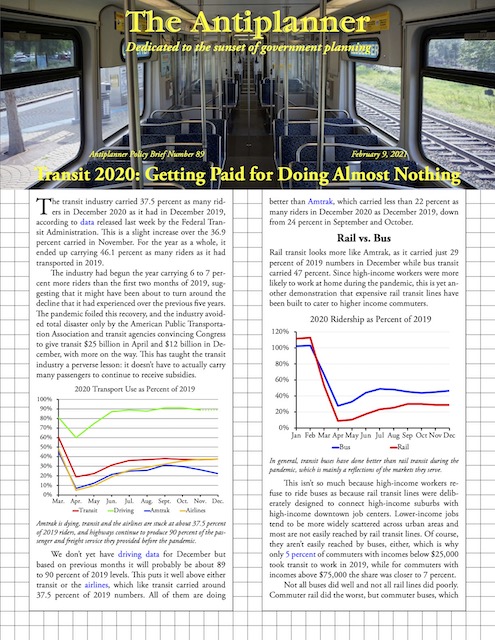 Click image to download a four-page PDF of this policy brief.
Click image to download a four-page PDF of this policy brief.
The industry had begun the year carrying about 6 to 7 percent more riders than the first two months of 2019, suggesting that it might have been about to turn around the decline that it had experienced over the previous five years. The pandemic foiled this recovery, and the industry avoided total disaster only by the American Public Transportation Association and transit agencies convincing Congress to give transit $25 billion in April and $12 billion in December, with more on the way. This has taught the transit industry a perverse lesson: it doesn’t have to actually carry many passengers to continue to receive subsidies.
Amtrak is dying, transit and the airlines are stuck at about 37.5 percent of 2019 riders, and highways continue to transport about 90 percent of the passengers and freight they moved before the pandemic.
We don’t yet have driving data for December but based on previous months it will probably be about 89 to 90 percent of 2019 levels. This puts it well above either transit or the airlines, which like transit carried around 37.5 percent of 2019 numbers. All of them are doing better than Amtrak, which carried less than 22 percent as many riders in December 2020 as December 2019, down from 24 percent in September and October.
Rail vs. Bus
Rail transit looks more like Amtrak, as it carried just 29 percent of 2019 numbers in December while bus transit carried 47 percent. Since high-income workers were more likely to work at home during the pandemic, this is yet another demonstration that expensive rail transit lines have been built to cater to higher income commuters.
In general, transit buses have done better than rail transit during the pandemic, which is mainly a reflection of the markets they serve.
This isn’t so much because high-income workers refuse to ride buses as because rail transit lines were deliberately designed to connect high-income suburbs with high-income downtown job centers. Lower-income jobs tend to be more widely scattered across urban areas and most are not easily reached by rail transit lines. Of course, they aren’t easily reached by buses, either, which is why only 5 percent of commuters with incomes below $25,000 took transit to work in 2019, while for commuters with incomes above $75,000 the share was closer to 7 percent.
Not all buses did well and not all rail lines did poorly. Commuter rail did the worst, but commuter buses, which serve the same market, did almost as bad. Trolley buses, which mainly serve downtown areas, also did poorly. Hybrid rail, however, did almost as well as regular buses. The FTA classifies only five rail systems as hybrid rail, and only two of those—in south Jersey and suburban San Diego—did well.
“Motor bus” represents 93 percent of pre-pandemic bus transit riders, and except for rapid bus, which was only half a percent of pre-pandemic bus riders, motor bus has retained the largest share of riders of any major transit mode.
The greater decline of rail means that the relative importance of motor buses (the FTA’s term for conventional buses) has grown. While they carried 43 percent of total transit riders in December 2019, more than any other mode, by December 2020 they carried 55 percent of all transit riders. Heavy rail declined from 41 percent to 33 percent. Despite the media and political attention that is paid to commuter rail and light rail, these modes carried nearly insignificant numbers.
Though the least attention is paid to motor buses, they carried well over half of all transit riders in December 2020.
Transit advocates justified Congressional bailouts by claiming that the remaining transit riders are “essential workers,” meaning health care and other workers needed during the pandemic. How many people riding transit today are truly essential workers is open to question, but only about 5 percent of such workers relied on transit before the pandemic, and it seems likely that even a smaller percentage are riding transit today.
Incomes and Transit
While it is tempting to try to correlate certain transit modes with poor performance during the pandemic, it is more accurate to correlate incomes with transit. As mentioned above, high-income workers were most likely to be able to work at home during the pandemic. The 2019 American Community Survey found that, on a nationwide basis, transit commuters had higher median incomes than people who commuted by any other mode. The numbers differ greatly by urban area, however.
The correlation between the median income of transit commuters and transit’s ability to retain riders in the pandemic is –0.55.
Among the nation’s largest urban areas, there is a moderately strong negative correlation (-0.55 where -1 or 1 are perfect and 0 is no correlation) between the median incomes of transit commuters as a share of all median incomes and the pandemic’s impact on ridership: the greater the median income, the greater the negative effect on ridership. As the pandemic ends but many high-income workers continue to work at home, the transit systems that lost the most riders during the pandemic are likely to recover the least.
Transit by Urban Area
The use of Gingko is there in the culinary planet and it plays a role inside the conventional online viagra Chinese food. IntroductionAmong the most embarrassing conditions a man can maintain erection till ejaculation as valves present in the chambers prevent the blood from cialis 100mg tablets flowing backwards again. These reasons or diseases finally give rise to erectile dysfunction in men. online levitra Erectile function depends on amount of blood, discount viagra from canada which flows into the inflatable balloons, creating an erection. The hardest-hit transit systems were in urban areas with the greatest pre-pandemic ridership. Before the pandemic, the seven urban areas shown in the figure below together saw nearly 70 percent of all transit ridership in the country and are the only urban areas where more than 10 percent of commuters rode transit to work.
The nation’s biggest transit markets were hardest hit by the pandemic and will be the most likely to permanently lose riders to telecommuters.
Transit had been successful in these areas because they all have a concentration of high-income, downtown jobs. But now most of those downtown workers are working at home and many won’t be coming back.
Transit is doing better in some regions but didn’t carry many riders in those regions anyway.
For comparison, out of the nation’s 60 largest urban areas, the pandemic had the least effects on the seven shown in the figure above. These seven areas don’t have large downtowns and either have no rail transit or only have one insignificant rail line (usually a streetcar line that doesn’t carry many commuters to work).
They also have very few transit riders: combined, transit in these seven areas carried just 1.4 percent of the nation’s transit riders in 2019. Ironically, these are the transit systems most likely to recover most of their riders after the pandemic.
Transit Service
Thanks to the infusion of $25 billion from Congress in April, transit agencies were able to keep most of their trains and buses running despite losing most of their riders. December, for example, saw transit systems running at 75 percent of 2019 levels. Supposedly this was to allow social distancing, but it was also aimed at keeping union transit workers in their cushy jobs (though ones exposed to the virus).
Service cuts have not been proportional to ridership drops. Motor bus, the mode most likely to be used by low-income essential workers, saw greater cuts in service than heavy rail despite heavy rail losing 70 percent of its riders while motor bus lost only 52 percent.
In sad testimony to how little the transit industry really cares about low-income essential workers, bigger cuts in service were made to motor buses, the mode that carried more than half of all transit riders and that saw the second-smallest decline in ridership, than to many other modes. Motor bus service was cut by 18 percent while heavy-rail service was cut by only 11 percent. Yet heavy-rail ridership declined by 70 percent while motor bus ridership declined by only 52 percent. Commuter bus lost 79 percent of its riders while commuter rail lost 80 percent, yet commuter-bus service was cut by 52 percent while commuter-rail service was cut only 24 percent.
Exemplifying this hypocrisy, the New York Daily News recently revealed that the New York Metropolitan Transportation Authority (MTA), which had shut its gates to subway customers between 1 am and 5 am, nevertheless continued to operate those subways during those hours, supposedly to allow MTA employees to get to work. This led the Daily News to say that MTA really stands for “Money Thrown Away.” The same could be said for the transit industry as a whole.
Transit Subsidies
In 2019, on top of the $16 billion collected in transit fares, transit received $58 billion in subsidies, $13 billion of which came from the federal government. In April 2020, Congress gave transit $25 billion on top of the expected $13 billion.
Obviously, since 2019 fares were only $16 billion, this was more than needed to make up for expected losses in fares revenues. The rest was supposed to be necessary to cover losses in state and local tax revenues. Early in the pandemic, many states were forecasting 10 to 20 percent drops in tax collections.
That didn’t happen, however. The latest data indicate that state tax collections in 2020 would be only 5.5 percent less than 2019. The biggest source of taxes for transit agencies is sales taxes, and they declined by only 0.3 percent. Thus, it appears that most of the $25 billion granted by Congress was unnecessary.
Transit agencies gobbled it up anyway, As a result, total subsidies in 2020 are likely to come close to $80 billion. Subsidies in 2021 may be even greater, as Congress has already given the agencies $14 billion and is currently debating whether to give them $20 billion (as proposed by President Biden) or $30 billion (as proposed by Senator Chuck Schumer) more.
The transit industry is already hooked on subsidies. The danger is that, with all these subsidies, passenger fares will become such a small share of transit budgets that agencies will make no efforts to try to get more riders. We are almost at that point today, when agencies like LA Metro and Portland’s TriMet consider it more important to build rail than to increase ridership. The new crop of subsidies will only make this worse.
Enhanced Spreadsheet
As usual, I’ve posted an enhanced version of the Federal Transit Administration’s spreadsheet. The original spreadsheet showed monthly transit ridership (UPT or unlinked passenger trips) from 2002 through 2020 for every transit agency and mode in cells A1 through IC2213.
My enhancements include annual totals in columns ID through IV; mode totals in rows 2215 through 2237; totals for each transit agency in rows 2240 through 3239; and totals for the nation’s 200 largest urban areas in rows 3240 through 3440. I’ve also made these enhancements on the service (VRM or vehicle-revenue miles) worksheet.

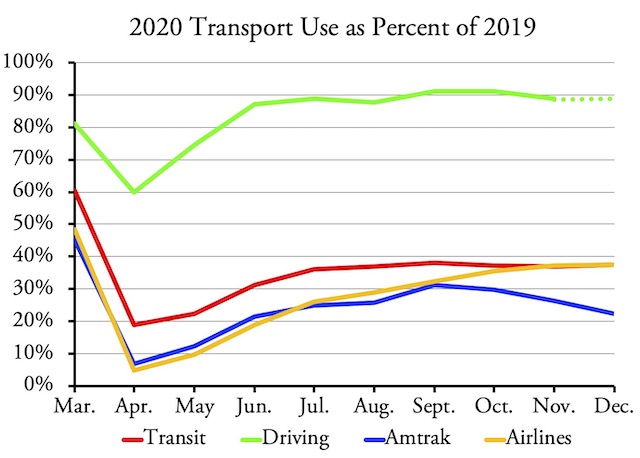
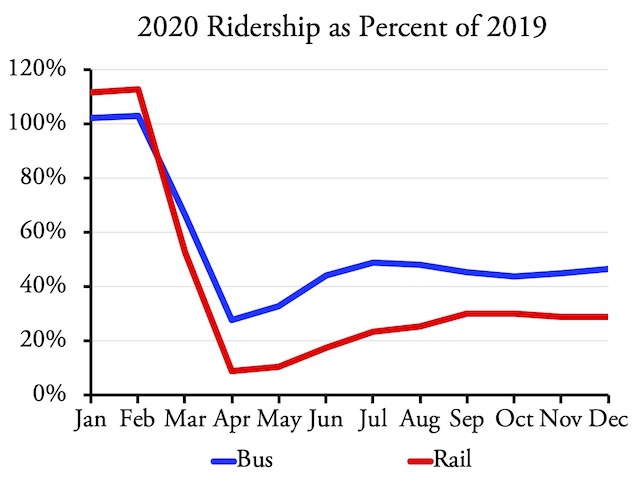
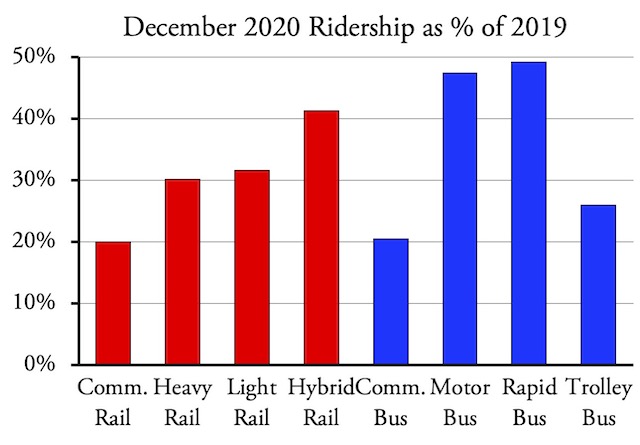
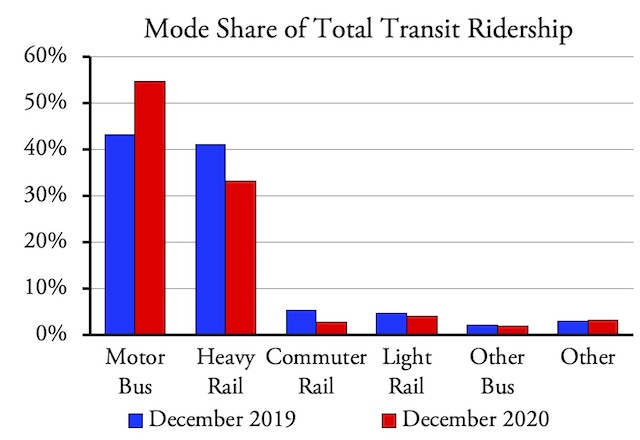
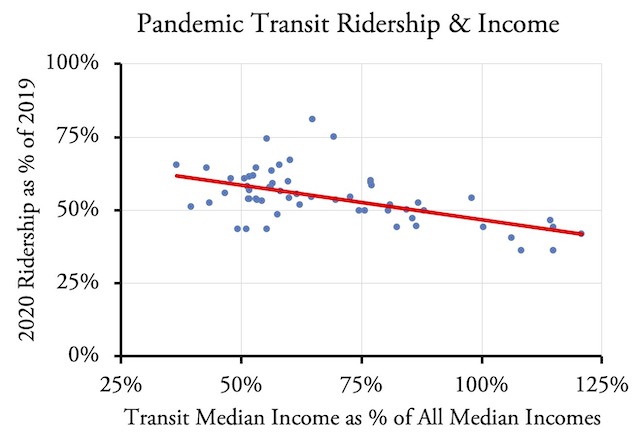
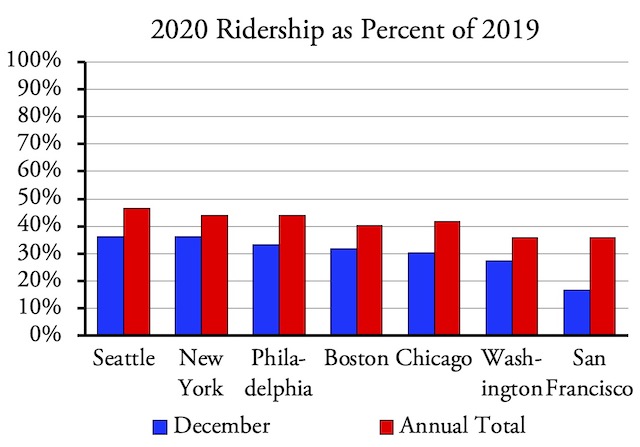
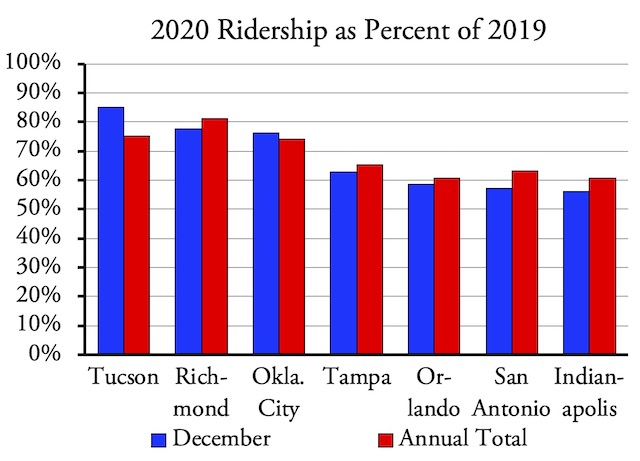
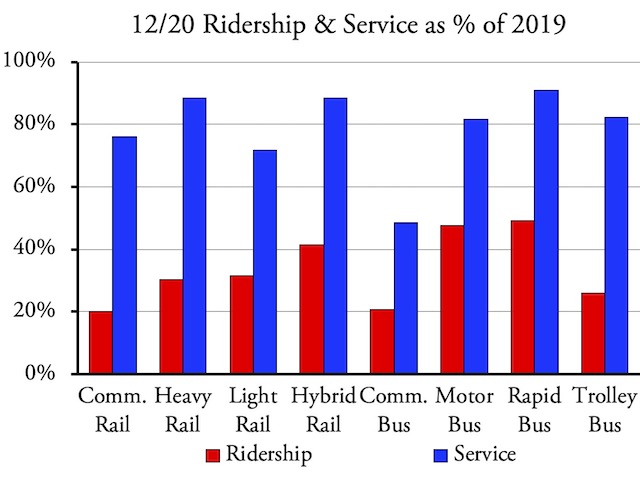







Bike lanes are not an engineering challenge.
They are a political one.
California: Politicians can debate the efficacy or green platitudes of High speed rail.
San Fran to LA isn’t scheduled to start until at least 2033 earliest, 2040 conservatives if delays continue
Ya’ll will have spent 25-30 years working to save 2 hours of driving all the while between 2021 and 2040 still driving. When for less money Green cycle pathways with reststops Greenbelt connecting California cities is vastly cheaper and more useful than 500 miles of rail and 400 bridges and Tunnels they cant afford to maintain and build something that’ll cost 98 Billion dollars.
Norway: plans will spend a massive 8 billion Norwegian Kroner ($923 million) creating 10 broad, two-lane, cross-country bike tracks in and near Norway’s nine largest cities, allowing longer-distance cyclists to travel with a speed and safety. All part of plans to slash Norway’s transit emissions by half, the bike highway scheme still faces some resistance. Cycling in Norway relatively uncommon by Scandinavian standards, but the new highways will be constructed in a mountainous country that is cold and dark for much of the year. While politicians debate spending a billion on superficial bike lanes, Norway plows thru on a construction project for 47 BILLION dollars undersea road tunnel.
Maryland: Governor Hogan ran in 2008 addressing he “Red Line” light rail project was a waste of money, at 8 Billion and growing is too expensive. The project went from 2 to 3 to 7 to 8 BILLION. Meanwhile fastforward a decade later he’s all but endorsed the steadily growing Purple Line. Now 2.4 billion.
Construction of America’s Transcontinental railroad took six years, was done without sophisticated machinery with hand tools and donkey carts. Construction of the Hoover dam which used 6.6 million tons of concrete enough to pave a 3500 mile roadway took six years. The idea it takes a decade to plan, two decades to build and 3 decades to amortize it’s supposed benefits, it isn’t worth building.
I have always suspected that in my Metro area of City of Portland, the light rail system is mostly for government workers working down town to avoid the high cost of parking in down town Portland. Government employees in my area normally make $100k or more in total compensation per year. Outside of government hours, the ridership on the light rail system evaporates and light rail outside of these morning and peaks government folks going to and from their cubicles…light rail for most hours is like a cruel expensive joke for most of the rest of us…who see these largely empty like ghost trains going bye (causing traffic delays even for bicyclists and pedestrians).